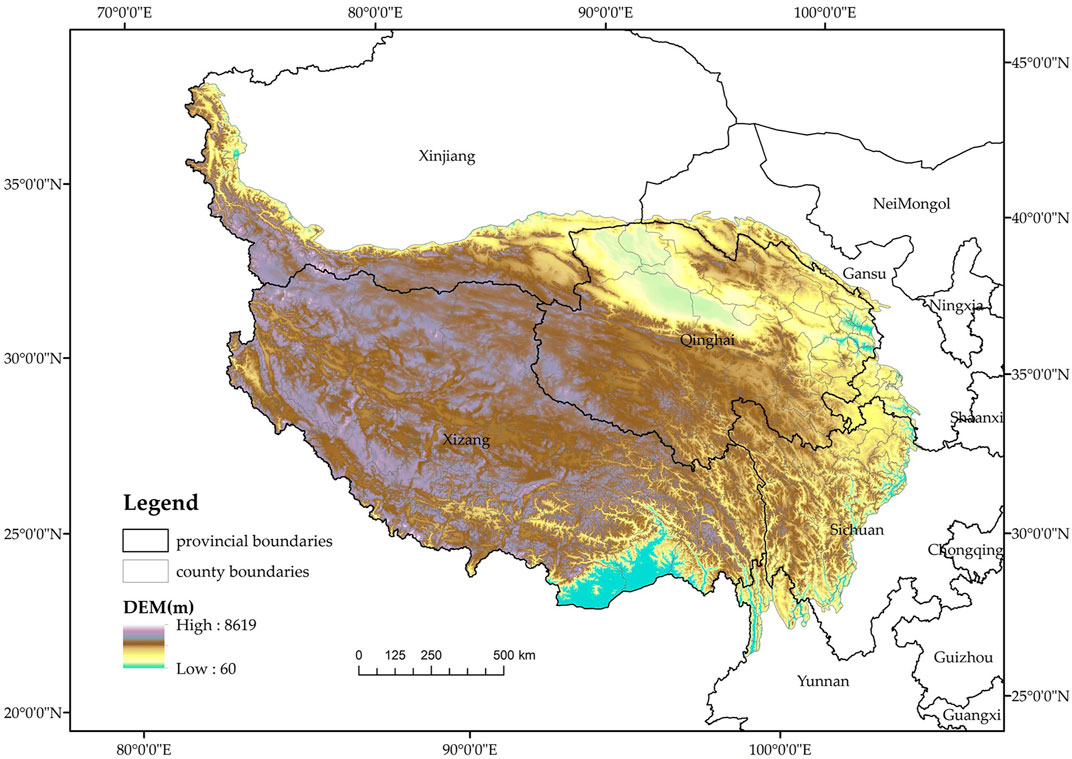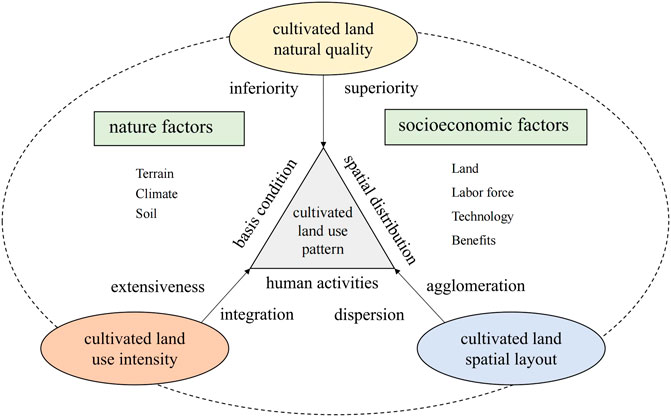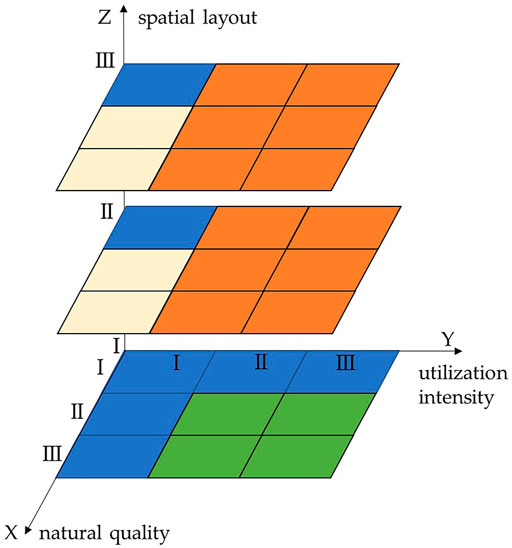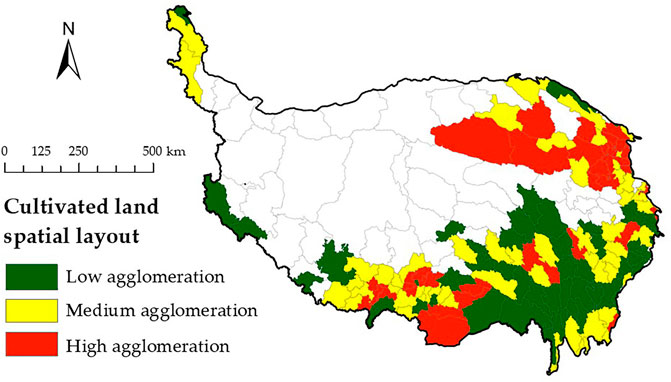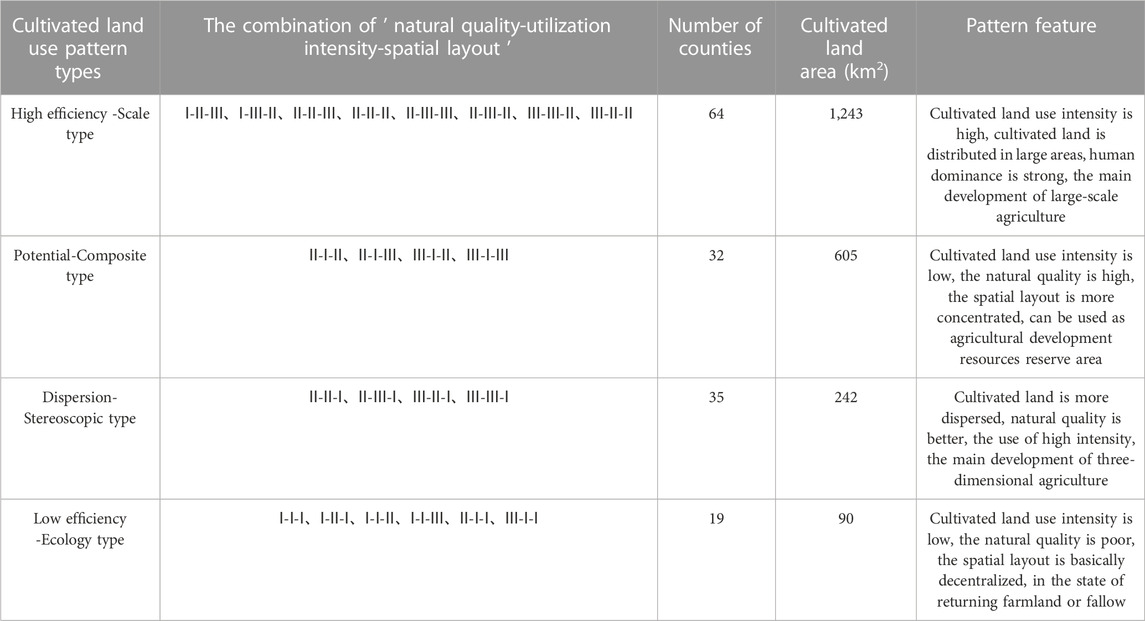- School of Natural Resources, Faculty of Geographical Science, Beijing Normal University, Beijing, China
The study of cultivated land use models is an important means to improve the benefit of cultivated land use and promote the sustainable use of cultivated land. The rational optimization of regional cultivated land use models based on the consideration of regional background conditions and development goals can provide a scientific basis for ensuring the sustainable use of cultivated land. This study constructed a three-dimensional research framework of "natural quality-utilization intensity-spatial layout" of cultivated land utilization pattern. Taking the county as a unit, the natural quality, spatial distribution and utilization intensity of cultivated land in the Qinghai-Tibet Plateau were evaluated, and the types of cultivated land utilization models were determined. Based on the ecological protection and the regulation and control of agriculture and animal husbandry in the Qinghai-Tibet Plateau, the optimization direction of cultivated land use patterns was discussed. The results show that the cultivated land use pattern divided by the “NUS” three-dimensional model can accurately reflect the characteristics of cultivated land use in the Qinghai-Tibet Plateau. The existing cultivated land use pattern in the Qinghai-Tibet Plateau is basically consistent with its ecological protection and development direction zoning, but the problems of unreasonable expansion and excessive use intensity of cultivated land exist in the ecotone between some development areas and restricted areas. Therefore, the utilization and optimization of cultivated land in the Qinghai-Tibet Plateau should be based on the premise of protecting ecological security and striving to solve the contradiction between agricultural development and ecological protection to realize the sustainable utilization of cultivated land.
1 Introduction
As the basic element of agricultural production (Zhou et al., 2021), the utilization and change of cultivated land has always been the focus of global attention (Arowolo and Deng, 2018; Chiemela et al., 2018). According to relevant research, the global population will continue to grow in the future. It is estimated that by 2050, the number of people will exceed 9.8 billion (Chouchane et al., 2018), and the food demand will increase by more than 50%, posing a serious challenge to global food production and ecological protection (Schiefer et al., 2016). In September 2015, the United Nations formally adopted the 2030 Agenda for Sustainable Development. The adoption of 17 development goals fully reflects three aspects, namely, economic development, social progress and environmental protection (Perez-Martinez et al., 2023). Sustainability with environmental protection as its goal requires human beings to adjust the relationship between themselves and the natural environment at any time to match the production development with the carrying capacity of resources and environment. (Bryan et al., 2018; Uusitalo et al., 2019; Bas et al., 2021). The corresponding agricultural development should fully consider the balanced relationship between food production and ecological protection. Especially in the context of China’s large population and small land area and the uneven distribution of cultivated land resources, how to correctly and effectively use cultivated land resources should be considered (Ye et al., 2020). Since the reform and opening up, significant changes have taken place in the use of cultivated land in China. The scale of planting has been expanding, and the intensity of utilization has been increasing. Although food production has increased and economic benefits have been brought, problems, such as the decline in cultivated land quality and ecological degradation, caused by the intensive use of cultivated land have become increasingly prominent (Ma et al., 2020; Chen et al., 2021). In the face of the increasingly serious problems of agricultural production and ecological protection in the use of cultivated land, the existing research focuses on how to scientifically select appropriate land use methods for different regions to achieve the goal of sustainable utilization of cultivated land.
The sustainable use of cultivated land requires a reasonable use mode that is suitable for a region’s natural and socioeconomic conditions to meet the local food and ecological protection needs in terms of quantity and quality (Wu et al., 2022). The cultivated land use pattern is a differentiated cultivated land use status proposed from a specific research scale and angle under the premise of comprehensively considering natural, social and economic factors (Liu, 2009; Zhang et al., 2019). At present, there is no clear theoretical definition of the concept of cultivated land use patterns in academic circles. Domestic and foreign scholars mostly focus on crop planting structure (Singh et al., 2011; Zhang et al., 2014; Balan et al., 2015; Mesgari and Jabalameli, 2018), farming methods (Dai et al., 2011; Balan et al., 2015; Jayne et al., 2016; Qiu and Wang, 2018), cultivated land use intensity (Chen et al., 2015; Ye et al., 2020), and the number and structure of cultivated land (Fezzi and Bateman, 2011; Yin et al., 2017; Foski, 2019; Zhang et al., 2020; Zhu and Xu, 2020) to define cultivated land use patterns. At the same time, scholars at home and abroad have used methods, such as farmer surveys (Jayne et al., 2016), Gao et al. (2018), (Mastrangelo et al., 2019), landscape indices (Yin et al., 2017; Foski, 2019), and model construction (Singh et al., 2011; Mesgari and Jabalameli, 2018; Ye et al., 2020) to delineate cultivated land use patterns. The research scale of cultivated land use patterns has gradually advanced from the household scale to the regional scale. However, most of the existing researchers describe cultivated land use patterns from a single perspective, the depiction of cultivated land use patterns is relatively simple, and they are mostly based on a certain index or a certain characteristic, such as per capita cultivated land area, cultivated land scale, structure, and cultivated land use intensity. While cultivated land is a composite system composed of multiple elements and affected by many aspects, the study of cultivated land use patterns is not only the expression of a single dimension or feature in the cultivated land system but also considers the reflections of different components in the system in various combinations. By studying the cultivated land use model and comparing it with the regional production conditions and development goals, the problem of unreasonable use of cultivated land can be solved at the source to achieve the goal of sustainable development.
The distribution of cultivated land resources in China is quite different, and high-quality cultivated land resources are mostly concentrated in the southeast plains and coastal areas (Xu et al., 2017). Therefore, previous research on the use of cultivated land has mainly focused on the main grain-producing areas, and less attention has been given to ecologically fragile areas with less cultivated land, such as the Qinghai-Tibet Plateau (Fan et al., 2020; Miao et al., 2021; Song et al., 2022). However, with the development of the social economy, the population of the Qinghai-Tibet Plateau is increasing (Gao et al., 2021), and foreign tourism is booming (Yang et al., 2021). The use of cultivated land on the Qinghai-Tibet Plateau not only needs to ensure the goal of food production, but also ecological protection, which is an arduous process. The goal is to rationally arrange the agricultural production space on the Qinghai-Tibet Plateau to balance agricultural production and ecological protection with power.
The Qinghai-Tibet Plateau is sparsely populated, bearing the ecological barrier function of China and even the world. Although its arable land area is small, its proportion in the total agricultural output value is equal to that of animal husbandry (Yang et al., 2019). Since 1980, climate warming has provided conditions for cultivated land reclamation. Social and economic development has prompted farmers and herdsmen to intensify the use of cultivated land. The area of cultivated land on the Qinghai-Tibet Plateau has increased from 956 km2 in 1990–2,180 km2 in 2020 (Liu et al., 2021). Under the pressure of long-term cultivated land expansion and intensive use, it is unknown whether the current situation of cultivated land use in the Qinghai-Tibet Plateau meets the local ecological protection requirements. Therefore, this paper constructs a three-dimensional pattern recognition framework of cultivated land use based on “natural quality-utilization intensity-spatial layout” and proposes the optimization direction of cultivated land use in different regions, in combination with the regional development goals of the Qinghai-Tibet Plateau, which provides a reference for the follow-up realization of sustainable use of cultivated land in the Qinghai-Tibet Plateau.
2 Study area and data gathering
2.1 Overview of the study area
The Qinghai-Tibet Plateau is vast and diverse in terrain, with an average elevation of more than 4,000 m. as shown in Figure 1. The main climate type is plateau mountain climate. The average annual temperature of the Qinghai-Tibet Plateau is between −5°C and 15.5°C. The temperature presents a “high low high” distribution pattern from the southeast to the northwest. The average annual temperature difference is 7.37°C. The average annual precipitation is about 415.3 mm. (Chen and Han, 2015). The spatial distribution of precipitation is uneven and gradually decreases from the southeast to the northwest. The precipitation center is located in the Nujiang River basin, Mekong River basin and Yangtze River basin in the southeast. The Qinghai-Tibet Plateau is rich in sunshine, with annual total solar radiation of 140–180 kcal/cm2, the total annual sunshine hours are 2500–3200 h. (Liang et al., 2013).The main land use of the Qinghai-Tibet Plateau is grassland and forest land. Restricted by terrain, temperature, irrigation and other conditions, the agricultural type is mainly valley agriculture, which is distributed in the One-River-Two-Tributaries basin and the Hung River valley area in the northeastern part of Qinghai Province. Compared with other regions, the temperature is higher, the frost-free period is longer, the heat is relatively sufficient, the terrain is flat, the soil is fertile, the water source is sufficient, the sunshine time is long, the water irrigation, the water and heat conditions are better, and it is more suitable for farming.
2.2 Data gathering and processing
The data used in this paper include land use data, DEM data, soil attribute data, annual average temperature, annual precipitation data, county-level administrative division vector data and agricultural and rural statistical yearbook data in the Qinghai-Tibet Plateau. The land use data came from the national remote sensing monitoring spatial distribution data of land use types from the Chinese Academy of Sciences’ Resource and Environmental Science and Data Center and are generated based on manual visual interpretation of Landsat TM images of the United States Landsat, with a resolution of 1 km; the annual average temperature and annual precipitation data are from the spatial interpolation dataset of annual average temperature and annual precipitation since 1980 by the Center for Resources and Environmental Science and Data of the Chinese Academy of Sciences; the county-level administrative division data came from the research results of the second research task of the second comprehensive scientific expedition to the Qinghai-Tibet Plateau; the DEM data came from the data of DEM 30 m by province (SRTM 30 m) in the data center of the Chinese Academy of Sciences; the soil attribute data came from the National Tibetan Plateau/Third Pole Environment Data Center (TPDC); and the agricultural data came from the statistical yearbooks of provinces, cities and counties in the Qinghai-Tibet region.
The DEM data of the provinces and the county-level administrative division data were fused and trimmed to obtain the DEM data of the Qinghai-Tibet Plateau. Some missing soil attribute data were filled by interpolation. The study removed the counties with 0 cultivated land area in 2020 and took the remaining 150 counties as the research object.
3 Methodology
This section is divided into subheadings. It should provide a concise and precise description of the experimental results, their interpretation, as well as the experimental conclusions that can be drawn.
3.1 Theoretical framework construction based on “NUS"
The cultivated land system is a complex system composed of many elements, which constitute an orderly cultivated land resource structure and maintain the balance of the cultivated land system (Hu et al., 2021). The long-term interaction between human agricultural planting activities and the ecological environment on different scales makes the use of cultivated land show various characteristics. It reflects the natural and economic attributes of the cultivated land use system. Its attributes include the natural quality and spatial form of cultivated land, and its social and economic attribute includes the utilization state of cultivated land by human beings. The natural quality of cultivated land is closely related to natural conditions, such as altitude, climate, and soil. It is the basis for determining the spatial distribution of cultivated land and is also affected by human activities. It is a prerequisite for judging whether a region is suitable for agricultural production activities and is the most basic guarantee factor (Cheng et al., 2012; Zhang et al., 2017; Chen et al., 2019). Cultivated land use intensity is a direct reflection of the degree of human utilization of cultivated land and the social and economic benefits and is used to measure the impact of human activities on cultivated land use (Li et al., 2019; Niu et al., 2019). The spatial layout of cultivated land is characterized by the shape and distribution of fields, reflecting the impact of changes in natural conditions and human activities on the distribution of cultivated land resources (Liu et al., 2021). From the perspective of the nature-humanity complex, the natural quality of cultivated land, the intensity of cultivated land use, and the spatial layout of cultivated land are important components of the cultivated land system, which run through the entire process of the development and change of the cultivated land system. Therefore, this study constructs a research framework of characteristics of cultivated land use based on “natural quality-utilization intensity-spatial layout” (NUS), which can reflect the characteristics of cultivated land use in the whole process along with multiple elements, which systematically describe the regional differences in cultivated land use patterns. The research framework is shown in Figure 2.
Agricultural sustainable development refers to the agricultural development pattern of resource conservation, environmental friendliness, industrial efficiency and farmers ' income increase in agriculture. To achieve sustainable agricultural development, we must first grasp the existing state of cultivated land use. The NUS framework combines the natural quality, utilization intensity and spatial layout of cultivated land, identifies the corresponding cultivated land use patterns, evaluates the overall cultivated land use status of the region, and determines the priority of regional agricultural development, which can provide a realistic basis for the rational utilization of cultivated land resources. The cultivated land utilization model identified under the NUS framework can enable the Qinghai-Tibet Plateau to develop regional characteristic agriculture according to local conditions, make full use of cultivated land resources on the basis of environmental protection, increase agricultural income, and achieve sustainable economic, social and ecological goals for agricultural development.
3.2 Research methods
3.2.1 Evaluation system of cultivated land use pattern
3.2.1.1 evaluation model of the natural quality of cultivated land
The niche model is a theoretical method used to estimate species distributions in ecology. Existing studies have extended the application of niche models to the field of geography to study the matching degree between regional resource space and the resource demand of regional development. In this paper, referring to previous research results (Xiao and Ou, 2022), based on the niche model, the natural quality of cultivated land and the natural environment correspond to regional development and resource space, and a natural quality evaluation model of cultivated land is established. The evaluation factors are divided into three categories:
Positive factor: the higher the value, the higher the natural quality of cultivated land. There are upper and lower limits. The evaluation model is:
Negative factor: the lower the value, the higher the natural quality of cultivated land. The evaluation model is:
Intermediate factor: The closer the solution is to the ideal value in a certain interval, the higher the natural quality of cultivated land. The evaluation model is:
The evaluation results of the natural quality of cultivated land:
In Formulas (1) ∼ 4),
Existing studies on the natural quality evaluation of cultivated land show that the natural conditions affecting the distribution and fertility of cultivated land include three categories: terrain, climate and soil (Xu et al., 2022). Soil is a prerequisite for farming and a necessary means of production. Soil organic matter content, pH and soil thickness affect soil texture; air temperature and precipitation conditions provide a suitable growth environment for crops, and topography affects the redistribution of surface water and heat conditions. Therefore, this study selects terrain factors (altitude, slope), climate factors (annual average temperature, average annual precipitation), and soil factors (soil pH, organic carbon content, soil layer thickness) to evaluate and classify the natural quality of cultivated land. Considering the suitability of the growth conditions of the four major crops of the Qinghai-Tibet Plateau, barley, wheat, pea, and rape, the thresholds of the evaluation factors were comprehensively determined (Table 1).
3.2.1.2 cultivated land spatial layout index
The landscape pattern index can condense landscape information, quantitatively reflect landscape structure composition and spatial configuration and is widely used in large-scale spatial layout research. Due to the strong correlation between many landscape pattern indices, the study refers to the results obtained by Ju et al. (2020), who conducted a correlation test and screening study on the spatial layout of land use and selected three landscape indices, namely, patch density, area weighted average nearest neighbor index, and area weighted patch nearest distance, to characterize the spatial layout of cultivated land. The patch density can reflect the intensity of patches, the area weighted average nearest neighbor index can measure the proximity of patches of the same type, and the area weighted patch nearest distance can reflect the dispersion or aggregation of patches of the same type. These three landscape pattern indices can reflect the aggregation and dispersion of patches in the landscape, but the calculation results are quite different. Therefore, a comprehensive index of cultivated land spatial layout was constructed, which can accurately reflect the aggregation and dispersion of cultivated land spatial layout by integrating the characteristics of the three indices. The formula for calculating the comprehensive index of cultivated land spatial layout is:
In the formula,
3.2.1.3 Evaluation of cultivated land use intensity
Cultivated land use intensity is an important way to measure the impact of human activities on cultivated land. Existing studies have carried out research on the characterization of cultivated land use intensity from multiple perspectives, such as planting, input‒output, intensification, and land use timing. Compared with the previous research results (Niu et al., 2019), the input‒output perspective is more suitable for the study of cultivated land use intensity in space, the variables involved are more comprehensive, and the results are more in line with the actual situation. This paper constructs the index system of cultivated land use intensity according to the logic of input‒output and following the principles of scientificity, rationality and availability of evaluation indicators. The input indicators reflect the amount of capital, labor and other production factors invested in the unit cultivated land area in the agricultural production process. In combination with previous research results, and taking into account the agricultural development situation and the availability of data in the Qinghai-Tibet Plateau region, four indicators were selected from the four aspects of technology, labor, fertilizer and land, including the total power of agricultural machinery, the number of rural employees, chemical fertilizer consumption, and sown area of crops. Output index refers to the social and economic benefits brought by certain input and utilization of cultivated land. Two indicators of total value of farm product and total grain output were selected. The entropy weight method was used to calculate the weight, and the evaluation index system of cultivated land use intensity was obtained as shown in Table 2.
3.2.2 Pattern recognition method of cultivated land use
In the form of a three-dimensional model, a recognition method of “natural quality-utilization intensity-spatial layout” of cultivated land use features was constructed as the theoretical basis for the classification of cultivated land use types. As shown in Figure 3, the natural quality, utilization intensity and spatial layout of cultivated land are taken as the X, Y, and Z axes respectively, the three indicators are divided into three grades from low to high according to the threshold value of the calculation results. According to the different forms and characteristics of cultivated land use in the study area, it is divided into four types of cultivated land use.
The study divides the counties whose utilization intensity and spatial layout are both grades II and III as High efficiency-Scale utilization pattern; the natural quality and spatial layout are classified as II and III grades, and the utilization intensity is grade I as Potential-Composite utilization pattern; The natural quality and utilization intensity of grades II and III, and the spatial layout of grade I are classified as Dispersion-Stereoscopic utilization pattern; those with at least two dimensions of natural quality, utilization intensity and spatial layout of grade I are classified as Low efficiency-Ecology utilization pattern.
4 Results
4.1 Characteristics of cultivated land use from different perspectives
4.1.1 Natural quality of cultivated land
The topography, climate, and soil natural quality of cultivated land in the study area were calculated, and the natural quality distribution interval of 0–1 was obtained. As shown in Figure 4, topographic and climatic factors greatly limit the natural quality of cultivated land. Mainly due to altitude restrictions, the high-altitude areas in the west were not suitable for crop growth. The southeastern part of the plateau is low in altitude, but the terrain fluctuates greatly, and the slope also has a certain restrictive effect on crop growth. From the climate evaluation results, more than 70% of the region does not provide enough natural precipitation and heat. The harsh natural conditions in the plateau and frigid regions with low temperature and low rainfall limit crop planting, and the remaining areas were concentrated between 0.316 and 0.5 and 0.707–0.866. The rivers and mountains in southern Tibet, Sichuan, and Yunnan are widely distributed, the altitude is low, and the natural precipitation and sunlight are relatively sufficient, which can provide natural growth conditions. The soil is less restrictive to crop planting on the Qinghai-Tibet Plateau, and the low-value areas are mainly distributed around the Qaidam Basin because the soil types are mostly salinized desert soil and gypsum desert soil, and the land is barren and has low organic matter content.
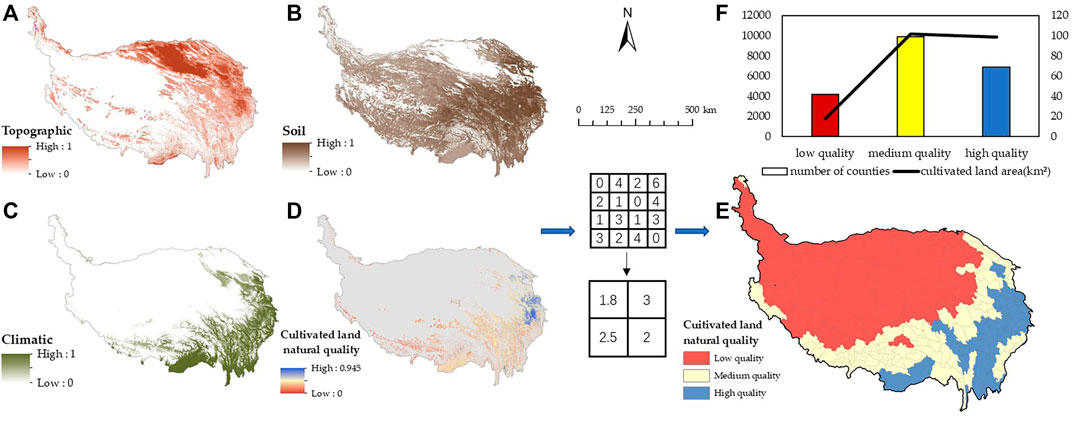
FIGURE 4. The division process and results of the natural background quality of cultivated land at the county scale on the Qinghai-Tibet Plateau is: (A) the result of terrain factor evaluation; (B) the result of soil factor evaluation; (C) the assessment result of climate factors; (D) the result of comprehensive evaluation; (E) the result of the processed county scale evaluation; and (F) the number of counties and cultivated land area involved under different natural quality levels.
Combined with the three factors of terrain, climate, and soil, the evaluation results of the natural background quality of cultivated land were finally determined. The averaged results were divided into three categories: low, medium and high according to the classification criteria of 0–0.029, 0.029–0.299, and 0.299–0.628, respectively. Low-quality, medium-quality, and high-quality counties cover a similar number of counties, but most of the cultivated land is distributed in medium- and high-quality areas, and the evaluation results are consistent with the actual situation (Figure 4).
4.1.2 Spatial layout of cultivated land
Combining the three landscape pattern indicators, the distribution of cultivated land in the counties of the Qinghai-Tibet Plateau was obtained (Table 3). The degree of arable land agglomeration has a strong correlation with the size of the area. The high agglomeration types are mainly distributed in the Hung River valley and the Qaidam Basin in Qinghai and Xigaze and Shannan in Tibet. They are the main agricultural development areas on the Qinghai-Tibet Plateau and can provide good agricultural production conditions. Most of the medium agglomeration types exist between valleys due to topographical constraints and are mostly distributed in strips, with strong connectivity and weak aggregation. The low aggregation type mainly exists in the border zone of Ganzi Tibetan Autonomous Prefecture in Sichuan, Tibet, Qinghai, Yunnan, Gansu and the plateau Frontier zone. The cultivated land area is small and scattered, which is not suitable for the development of large-scale agriculture and involves the least cultivated land area (Figure 5).
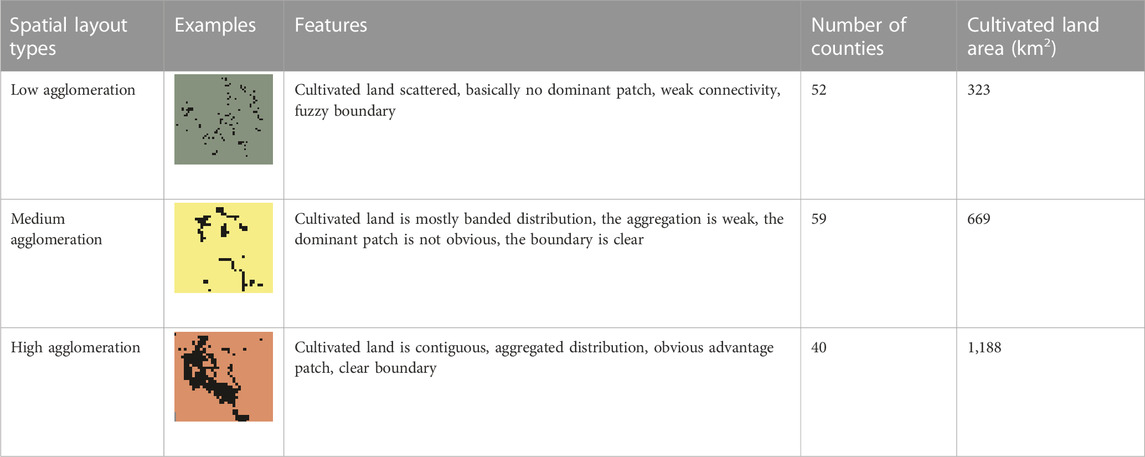
TABLE 3. Types and characteristics of the spatial layout of cultivated land at the county scale on the Qinghai-Tibet Plateau.
4.1.3 Cultivated land use intensity
Figure 6 shows the calculation results and spatial distribution of cultivated land use intensity. The range of cultivated land use efficiency results on the Qinghai-Tibet Plateau is 0.010–0.019. According to the natural discontinuous point method, the calculation results of cultivated land use intensity are divided into three intensity levels: low, medium, and high. Among them, the high-intensity utilization of cultivated land involves the largest area of cultivated land, mainly concentrated in the Hung River valley of Qinghai and its surrounding counties. The Hung River valley is rich in labor resources and advanced agricultural technology, and the government vigorously supports the development of modern new agriculture, which is the main agricultural area in Qinghai Province. The number of counties involved in medium-intensity utilization is the largest, mainly distributed at the junction of Sichuan, Yunnan, Qinghai and Tibet, and the input is at a low level. The lack of labor and the scattered distribution of cultivated land limit the utilization of cultivated land. The counties with low cultivated land use intensity are distributed in the “One-River-Two-Tributaries” basin, Changdu, Linzhi area in Tibet, and the western edge of the plateau. Although these areas are the main agricultural planting areas in Tibet, their productivity and agricultural technology promotion are backwards, and the overall use intensity is low.

FIGURE 6. Spatial distribution of cultivated land use intensity evaluation results (A); number of counties and cultivated land area included in different grades of cultivated land use intensity (B).
4.2 Recognition results of cultivated land use patterns
The classification results of cultivated land use pattern recognition according to the three-dimensional mode can be seen (Table 4; Figure 7):

FIGURE 7. Three-dimensional ensemble results of cultivated land use pattern (A); Spatial distribution results of cultivated land use pattern (B).
High efficiency-Scale utilization pattern area involved a total of 64 counties, with a cultivated land area of 12,428 km2 (57.02%), mainly distributed in the Hung River valley of Qinghai, Sichuan, and the southern edge of Yunnan. The cultivated land use intensity was medium and high intensity, and the spatial layout also had a high degree of concentration, mostly professional production of large-scale crop cultivation and a high level of agriculture. With the exception of a few counties in Qinghai and Tibet that are on the fringe of cultivated land distribution, more than 90% of the counties have high natural quality cultivated land, which provides a prerequisite for the large-scale utilization of cultivated land. This pattern utilizes natural and economic advantages to increase the input of agricultural production factors, improve infrastructure conditions, improve grain output efficiency, broaden agricultural development channels, and give full play to agricultural economic benefits. It is a key area for modern agricultural development on the Qinghai-Tibet Plateau.
Potential-Composite utilization pattern area consists of 32 counties, with a cultivated land area of 6,044 km2 (27.73%), which is concentrated in the area of the “One-River-Two-Tributaries” basin in Tibet. The nearly closed ecological environment has formed unique natural conditions in the area of the One-River-Two-Tributaries basin. It is rich in water resources, suitable for climate resources, concentrated land and easy to cultivate. The natural quality of cultivated land in this pattern is medium to high grade, and the spatial distribution of cultivated land is relatively concentrated, but the use intensity of cultivated land is not high, and the potential of cultivated land use is large. The counties around Shigatse develop industrialized and business-oriented agriculture, and the counties around Lhasa and Shannan in the Tibet Autonomous Region have developed animal husbandry. Relying on their own natural, economic and regional advantages, they have established a variety of complex, circular and ecological agricultural development modes. The region makes full use of its own conditions to develop suitable agriculture according to local conditions and builds a plateau with a characteristic agricultural development base.
Dispersion-Stereoscopic utilization pattern involves 35 counties, with an area of 2,423 km2 (11.12%) of arable land. It is basically located in the Hengduan Mountains and its surrounding areas. The terrain is undulating, the mountain is high, the valley is deep, the climate difference is large, and the vertical differentiation is significant. The natural quality and utilization intensity of cultivated land in this pattern are generally high, and the spatial distribution is too scattered, which is not suitable for the development of large-scale agriculture. However, it has obvious geographical advantages and is suitable for the development of three-dimensional agriculture. For example, the ganzi tibetan autonomous prefecture of Sichuan Province relies on its own industrial advantages to create “special, refined and excellent” rural characteristic agriculture, establish a characteristic agriculture and forestry industry base, and promote the development of plateau characteristic agriculture.
Low efficiency-Ecology utilization pattern area includes a total of 19 counties, involving the least cultivated land area, accounting for only 902 km2 (4.14%), scattered in the southern edge of Xinjiang, the southern border of the plateau and the central plateau of the plateau and is not the main area of agricultural development. The scale of cultivated land is small, the location is remote, and the cost of cultivation is high. The natural quality, spatial layout and utilization intensity of cultivated land in this pattern are basically at a low level, and the basic conditions for agricultural development are relatively poor. In recent years, the protection and construction of cultivated land basic farmland in the Qinghai-Tibet Plateau has been strengthened, and the areas unsuitable for cultivated land development have gradually clarified the development direction and ensured ecological priority development.
4.3 Optimization of cultivated land use pattern
Referring to the results of ecological protection and agricultural and animal husbandry development regionalization of the Qinghai-Tibet Plateau divided by Lu Changhe (Lv and Liu, 2020) and others, this paper combines the existing research contents and needs and divides the Qinghai-Tibet Plateau into three regions according to the overall development direction: agricultural development area, agricultural and animal husbandry development area and agricultural and animal husbandry development limited control area. As shown in Figure 8 and Table 5, the three major development zones of the Qinghai-Tibet Plateau and the identification results of cultivated land use are compared, and optimization suggestions are proposed for the existing cultivated land use pattern.
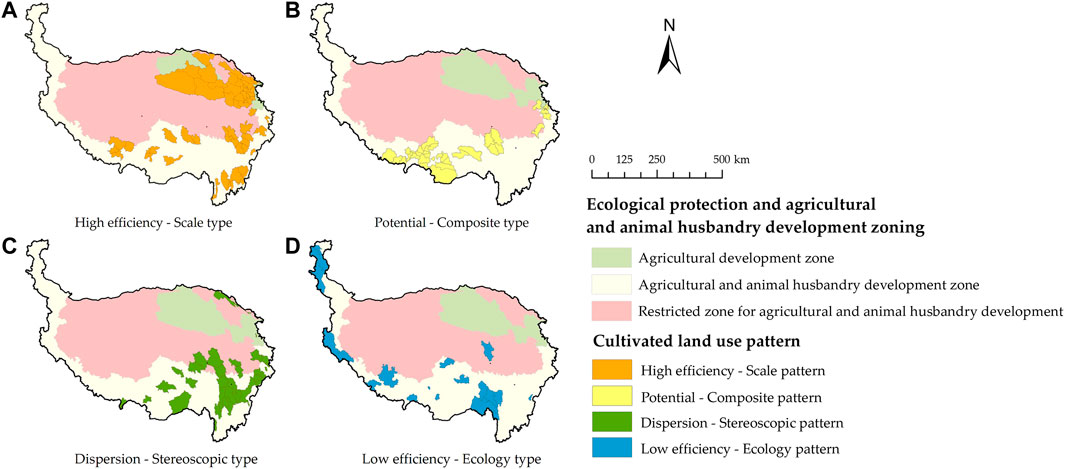
FIGURE 8. Optimized zoning of cultivated land use patterns on the Qinghai-Tibet Plateau: (A) High efficiency-Scale type; (B) Potential-Composite type; (C) Dispersion-Stereoscopic type; (D) Low efficiency-Ecology type.
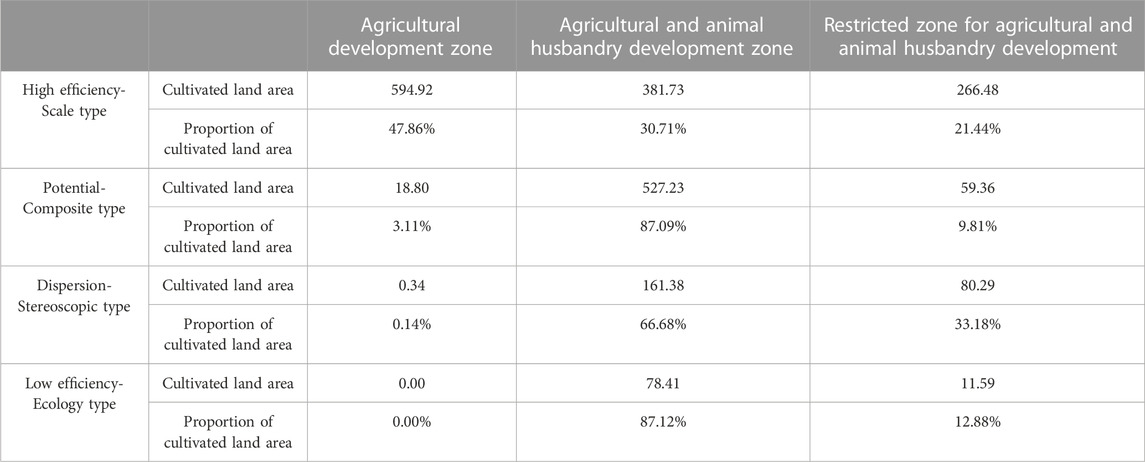
TABLE 5. Number of counties and cultivated land area in optimized subregions of cultivated land use pattern.
Approximately 80% of the counties in the High efficiency-Scale utilization pattern are located in agricultural development areas and agricultural and animal husbandry development areas, and a small number of counties around the Hung River valley, such as Qilian County and Gangcha County, are in the restricted area for agricultural and animal husbandry development. The use of cultivated land in the main production areas should be strictly controlled, and ecological protection should be prioritized. In addition, Seda County, Ganzi County in Sichuan, etc., are located in the critical region, and the scope of cultivated land expansion should also be strictly limited. Approximately 87% of the counties in the Potential-Composite utilization pattern are in the agricultural and animal husbandry development area, 3% are in the agricultural development area, and 10% are in the development restricted area. The county and Xiahe County should pay attention to coordination and ecological protection while flexibly optimizing the agricultural development pattern.
Approximately 67% of the counties in the Dispersion-Stereoscopic utilization pattern are in the agricultural and animal husbandry development zone, and nearly 33% of the counties are in the restricted and controlled agricultural and animal husbandry development zone, including Sunan County, Gansu Province, Yushu County, and Nangqian County in Qinghai Province. Banma County, Rangtang County, Shiqu County and Dege County in Sichuan Province have expanding cultivated land, and most of them are newly added cultivated land. The expansion of cultivated land does not consider whether it will affect the habitat of wild animals, and water conservation and protection areas have caused certain conflicts between agricultural development and ecological protection. The Low efficiency-Ecology utilization patterns are all distributed in the agricultural and animal husbandry development areas and restricted control areas; the county of the agricultural and animal husbandry development area accounts for approximately 85%, and the county of the agricultural and animal husbandry restricted control area accounts for approximately 15%. The natural and spatial distribution conditions of cultivated land in Chengduo County in the restricted control area are not suitable for agricultural development, and the existing pattern should be maintained to reduce the use of cultivated land.
5 Discussion
5.1 Reasons for the formation of cultivated land use patterns in different regions of the Qinghai-Tibet Plateau
The Qinghai-Tibet Plateau has a vast territory, with large differences in natural endowment and population density among regions (Gao et al., 2021) and different development goals and priorities. Therefore, there are certain differences in the use of cultivated land in different regions. Due to the limitations of altitude, soil and climate factors, the cultivated land on the Qinghai-Tibet Plateau is mainly distributed in the Hung River valley area, the Yarlung Zangbo River Valley and the southeast edge of the plateau. In addition, the influence of the labor force, agricultural production technology and other factors determines the distribution range of the main agricultural production areas on the Qinghai-Tibet Plateau. In addition, the mountain vertical belt in the southeast of the Qinghai-Tibet Plateau, formed by natural conditions, has a low altitude and good light and temperature conditions. The distribution of alpine shrubs and meadows is suitable for grazing. The mountain forest belt in the middle provides people with wood, fuel, etc., showing typical mountain land three-dimensional utilization characteristics. In addition to natural conditions, national policies also affect the use of cultivated land on the Qinghai-Tibet Plateau. The Ecological Protection Law of the Qinghai-Tibet Plateau (Draft) proposes to strictly take ecological protection as the prerequisite and forcibly return farmland in some high-altitude or low-temperature areas, which also makes some areas in Tibet unsuitable for efficient and large-scale use of cultivated land. Many factors, such as nature, human activities and national policies, have formed the current situation of cultivated land use differentiation in the Qinghai-Tibet Plateau.
5.2 Rationality of optimizing the utilization of existing cultivated land in the Qinghai-Tibet Plateau by dividing agriculture and animal husbandry development zones
The research results show that since 2002, the planting structure of the Qinghai-Tibet Plateau has undergone a major transition, gradually reducing the sowing of food crops and increasing the proportion of cash crops (Liu et al., 2016). With the growth of the population and the continuous improvement of productivity, agriculture and animal husbandry have developed rapidly, and the scale and intensity of cultivated land use have increased. Most regions have a strong dependence on cultivated land resources, and cultivated land use shows strong regional differences (Liu et al., 2021). Since the 18th National Congress of the Communist Party of China, the state has attached great importance to the ecological protection of the Qinghai-Tibet Plateau, strengthened the systematic protection and risk prevention of the Qinghai-Tibet Plateau, and made ecological protection a prerequisite for regional development (Fan and Fang, 2022). Therefore, to maintain the sustainable use of cultivated land in the Qinghai-Tibet Plateau, it is necessary to arrange agricultural production according to the development goals of different regions and local conditions. The ecological protection and agricultural and animal husbandry regulation zoning of the Qinghai-Tibet Plateau proposed by Lv Changhe et al. has taken into account the terrain (elevation, slope), vegetation types and coverage, land use status and agricultural use types, distribution of nature reserves, ecological protection priorities and agricultural development directions. The zoning results have been applied to a number of studies related to the ecological security protection of the Qinghai-Tibet Plateau, with strong practical significance. They can be used as a basis to judge whether the cultivated land use in the Qinghai-Tibet Plateau is reasonable at the county level.
5.3 Whether optimized cultivated land utilization meets the needs of agricultural production and ecological protection
The cultivated land use pattern and ecological protection of most counties in the Qinghai-Tibet Plateau are consistent with the agricultural and animal husbandry development zoning. However, there is still a conflict between agricultural development and ecological protection in the agricultural development area, the agricultural and animal husbandry development area and the agricultural and animal husbandry development restricted area. Thus, the phenomenon of occupying the resources in the restricted area needs to be adjusted. For counties at the critical point of zoning, it is recommended to give priority to the development of high-quality cultivated land and unused land within the region, activate idle cultivated land within the region, and prohibit the spread of new cultivated land to the surrounding restricted areas. The counties located in the restricted areas should continue to implement the project of returning farmland to forests, implement the responsibility system of local governments for farmland protection objectives. By optimizing and adjusting the utilization of existing cultivated land in the Qinghai-Tibet Plateau, focusing on the use of high-quality cultivated land resources, reducing unreasonable development and utilization, and effectively alleviating the contradiction between agricultural production and ecological protection in various regions. In addition, the optimization of cultivated land use can also reasonably allocate water resources supply to a certain extent, reduce agricultural non-point source pollution caused by large-scale use of chemical fertilizers and pesticides, improve soil quality, alleviate soil erosion caused by large-scale reclamation of cultivated land, follow the boundary of nature reserves, and protect the biodiversity of the Qinghai-Tibet Plateau.
6 Conclusion
The Qinghai-Tibet Plateau is an important ecological barrier area in China. In order to achieve the goal of sustainable use of cultivated land, the use of cultivated land in this area needs to strictly follow the principle of giving priority to ecological environment protection. This paper constructs an analysis framework of cultivated land use patterns based on the three-dimensional model of natural quality-utilization intensity-spatial layout (NUS). On this basis, the types of cultivated land use patterns in the study area was identified, and the optimization direction of cultivated land use patterns at the county scale in the Qinghai-Tibet Plateau was proposed based on the ecological protection and agricultural and animal husbandry development division of the Qinghai-Tibet Plateau. The main conclusions are as follows:
There are four different patterns of cultivated land use in the Qinghai-Tibet Plateau. High efficiency-Scale utilization pattern of cultivated land use intensity is high, the spatial distribution of cultivated land is agglomerated, and large-scale agriculture is mainly developed; Potential-Composite utilization pattern of cultivated land use intensity is low, but the natural quality is high, and the spatial layout is relatively concentrated, which can be used as a reserve area for agricultural development resources; Dispersion-Stereoscopic utilization pattern of cultivated land is relatively scattered, with high natural quality and high utilization intensity, and the three-dimensional agriculture is mainly developed; Low efficiency-Ecology utilization pattern of cultivated land has low utilization intensity, poor natural quality, and the spatial layout is basically decentralized. In a state of abandonment or fallow.
Comparing the results of the development zoning of the Qinghai-Tibet Plateau, all four types of cultivated land use patterns are in the restricted area of agricultural and animal husbandry development. Counties with High efficiency-scale, Potential-composite, and Dispersion-stereoscopic utilization patterns located at the borders of agricultural and animal husbandry development control areas should strictly limit the scale of cultivated land and coordinate the relationship between agricultural and animal husbandry development and ecological protection. Counties with Low efficiency-Ecology patterns should continue to maintain the existing state of utilization and put the restoration of the ecology first.
According to the research results, in order to realize the sustainable utilization of cultivated land in the Qinghai-Tibet Plateau in the future, we should first implement a strict ecological environment protection system, determine the use of major natural resources such as water, cultivated land, grassland and forest, set the bottom line of environmental protection such as the use of chemical fertilizers and pesticides, the total amount of water and gas pollution emissions, establish and improve the regional red line management system, strictly control the new land use, and revitalize the stock land. Secondly, it is necessary to develop plateau characteristic industries according to local conditions, build an eastern and southeastern plateau characteristic ecological agricultural belt with the One-River-Two-Tributaries basin and the Hung River valley area as the main body, and vigorously develop plateau characteristic ecological animal husbandry in the Sanjiangyuan Regin, western and northern Tibet. It emphasizes the combination of agriculture and animal husbandry, accelerates the industrialization of agriculture and animal husbandry, promotes the comprehensive development of various agricultural and animal husbandry methods, attaches importance to the role of ecological agriculture in promoting agricultural and animal husbandry development and ecological environment protection, and gradually realizes the virtuous cycle of agricultural and animal husbandry economic development and ecological environment protection.
Data availability statement
The original contributions presented in the study are included in the article/supplementary material, further inquiries can be directed to the corresponding author.
Author contributions
Conceptualization, methodology, visualization and writing—original draft preparation, XW; investigation, resources, CP; writing—review and editing, supervision, project administration, DZ and GJ. All authors have read and agreed to the published version of the manuscript.
Funding
This research was funded by the Second Tibetan Plateau Scientific Expedition and Research Program, Grant No.2019QZKK0405.
Acknowledgments
We are also grateful for the comments and criticisms of the journal’s reviewers and our colleagues.
Conflict of interest
The authors declare that the research was conducted in the absence of any commercial or financial relationships that could be construed as a potential conflict of interest.
Publisher’s note
All claims expressed in this article are solely those of the authors and do not necessarily represent those of their affiliated organizations, or those of the publisher, the editors and the reviewers. Any product that may be evaluated in this article, or claim that may be made by its manufacturer, is not guaranteed or endorsed by the publisher.
References
Arowolo, A. O., and Deng, X. Z. (2018). "Land use/land cover change and statistical modelling of cultivated land change drivers in Nigeria.". Reg. Environ. Change 18 (1), 247–259. doi:10.1007/s10113-017-1186-5
Balan, A. V., Toma, E., Dobre, C., and Soare, E. (2015). Organic farming patterns analysis based on clustering methods. LIFE Agric. 6, 639–646. doi:10.1016/j.aaspro.2015.08.110
Bas, T., Kara, F., and Alola, A. A. (2021). The environmental aspects of agriculture, merchandize, share, and export value-added calibrations in Turkey.". Environ. Sci. Pollut. Res. 28 (44), 62677–62689. doi:10.1007/s11356-021-15171-z
Bryan, B. A., Gao, L., Ye, Y., Sun, X., Connor, J. D., Crossman, N. D., et al. (2018). "China's response to a national land-system sustainability emergency.". Nature 559 (7713), 193–204. doi:10.1038/s41586-018-0280-2
Chen, G. Q., and Han, M. Y. (2015). Global supply chain of arable land use: Production-based and consumption-based trade imbalance. LAND USE POLICY 49 (SI), 118–130. doi:10.1016/j.landusepol.2015.07.023
Chen, L., Chang, J. X., Wang, Y. M., Guo, A. J., Liu, Y. Y., Wang, Q. Q., et al. (2021). "Disclosing the future food security risk of China based on crop production and water scarcity under diverse socioeconomic and climate scenarios." Sci. Total Environ. 790. doi:10.1016/j.scitotenv.2021.148110
Chen, X., An, S., Inouye, D. W., and Schwartz, M. D. (2015). "Temperature and snowfall trigger alpine vegetation green-up on the world's roof.". Glob. Change Biol. 21 (10), 3635–3646. doi:10.1111/gcb.12954
Chen, X. P., Fang, K., Wu, C. F., Wang, T. Y., and Long, Y. (2019). A study on spatio-temporal changes in patterns of China's cultivated land use from 2009 to 2015.". Bull. Soil Water Conservation 39 (3), 291–296. doi:10.13961/j.cnki.stbctb.2019.03.047
Cheng, W. M., Chai, H. X., Fang, Y., Zhou, C. H., Tian, C. Y., Wu, S. X., et al. (2012). Analysis of cultivated land based on water resources regionalization and geomorphologic characteristics in Xinjiang, China. J. Nat. Resour. 27 (11), 1809–1822.
Chiemela, S. N., Noulekoun, F., Zenebe, A., Abadi, N., and Birhane, E. (2018). Transformation of degraded farmlands to agroforestry in Zongi Village, Ethiopia. Agrofor. Syst. 92 (5), 1317–1328. doi:10.1007/s10457-017-0076-7
Chouchane, H., Krol, M. S., and Hoekstra, A. Y. (2018). "Expected increase in staple crop imports in water-scarce countries in 2050.". Water Res. X 1. doi:10.1016/j.wroa.2018.09.001
Dai, K., Cai, D. X., Zhang, X. M., Wang, Y., Zhao, Q. S., Zhang, D. C., et al. (2011). "Effects of nitrogen and phosphorus on dry farming spring corn yield and water use efficiency under different tillage practices.". Trans. CSAE 27 (02), 74–82. doi:10.02-6819/(2011)27:2<74:BTGZMS>2.0.TX;2-X
Fan, J. Q., Wang, L., Qin, J. X., Zhang, F. R., and Xu, Y. (2020). Evaluating cultivated land stability during the growing season based on precipitation in the Horqin Sandy Land, China. J. Environ. Manag. 276. doi:10.1016/j.jenvman.2020.111269
Fan, Y. P., and Fang, C. L. (2022). "Measuring Qinghai-Tibet plateau?s sustainability.". Sustain. Cities Soc. 85. doi:10.1016/j.scs.2022.104058
Fezzi, C., and Bateman, I. J. (2011). "Structural agricultural land use modeling for spatial agro-environmental policy analysis.". Am. J. Agric. Econ. 93 (4). doi:10.1093/ajae/aar037
Foski, M. (2019). Using the parcel shape index to determine arable land division types. ACTA Geogr. GEOGR. ZB. 59 (1), 83–101. doi:10.3986/ags.4574
Gao, J., Strijker, D., Song, G., and Li, S. P. (2018). "Drivers behind farmers' willingness to terminate arable land use contracts.". Tijdschr. VOOR Econ. En. Soc. Geogr. 109 (1), 73–86. doi:10.1111/tesg.12261
Gao, X. C., Li, T., and Sun, D. Q. (2021). Regional differentiation regularity and influencing factors of population change in the Qinghai-Tibet Plateau, China. Chin. Geogr. Sci. 31 (5), 888–899. doi:10.1007/s11769-021-1223-7
Hu, Y. M., Yang, H., Zou, R. Y., Shi, Z., Wu, W. B., Wu, L., et al. (2021). "Evolution and prospect of systematic cognition on the cultivated land resources.". J. Agric. Resour. Environ. 38 (6), 937–945. doi:10.13254/j.jare.2021.0711
Jayne, T. S., Chamberlin, J., Traub, L., Sitko, N., Muyanga, M., Yeboah, F. K., et al. (2016). "Africa's changing farm size distribution patterns: The rise of medium-scale farms.". Agric. Econ. 471, 197–214. doi:10.1111/agec.12308
Ju, H. R., Zuo, L. J., Zhang, Z. X., Zhao, X. L., Wang, X., Wen, Q. L., et al. (2020). "Methods research on describing the spatial pattern of land use types in China.". Acta Geogr. Sin. 75 (01), 143–159. doi:10.11821/dlxb202001011
Li, Z. J., Yu, Y. H., and Jiang, A. X. (2019). "Temporal variations and driving factors of cultivated land use intensity in shandong province from 1980 to 2015.". J. Resour. Ecol. 10 (3), 265–274. doi:10.5814/j.issn.1674-764x.2019.03.004
Liang, L., Li, L., Liu, C., and Cuo, L. (2013). Climate change in the Tibetan plateau three rivers source region: 1960-2009. Int. J. Climatol. 33 (13), 2900–2916. doi:10.1002/joc.3642
Liu, H. F., Bi, R. T., Guo, Y. L., and Wang, J. (2021). "Protection zoning of cultivated land based on form - structure - function multidimensional evaluation system.". J. Agric. Mach. 52 (02), 168–177. doi:10.6041/j.issn.1000-1298.2021.02.015
Liu, Y. S. (2009). "Innovation of land use strategies and its model system in China.". China Land Sci. 23 (02), 4–10. doi:10.13708/j.cnki.cn11-2640.2009.02.006
Liu, Y. X., Liu, S. L., Sun, Y. X., Wang, F. F., and Li, M. Q. (2021). "Driving forces of cultivated land evolution in agro-pastoral areas on the Qinghai-Tibet Plateau based on ecological niche theory.". J. Clean. Prod. 313. doi:10.1016/j.jclepro.2021.127899
Liu, Z. H., Yang, P., Wu, W. B., Li, Z. G., and You, L. Z. (2016). "Spatio-temporal changes in Chinese crop patterns over the past three decades.". Acta Geogr. Sin. 71 (05), 840–851. doi:10.11821/dlxb201605012
Lv, C. H., and Liu, Y. Q. (2020). "Regulatory division map for ecological protection and agriculture and animal husbandry on the Tibetan Plateau (2018).". Natl. Tibet. Plateau Data Cent. doi:10.11888/Geogra.tpdc.270439
Ma, E. P., Cai, J. M., Lin, J., Guo, H., Han, Y., and Liao, L. W. (2020). "Spatio-temporal evolution of global food security pattern and its influencing factors in 2000-2014.". Acta Geogr. Sin. 75 (02), 332–347. doi:10.11821/dlxb202002009
Mastrangelo, M. E. Z., Sun, L., Seghezzo, L., and Müller, D. (2019). "Survey-based modeling of land-use intensity in agricultural frontiers of the Argentine dry Chaco.". Land Use Policy 88. doi:10.1016/j.landusepol.2019.104183
Mesgari, I., and Jabalameli, M. S. (2018). Modeling the spatial distribution of crop cultivated areas at a large regional scale combining system dynamics and a modified dyna-CLUE: A case from Iran. Agric. Week. doi:10.5424/sjar/2017154-10630
Miao, Y. B., Liu, J. J., and Wang, R. Y. (2021). Occupation of cultivated land for urban-rural expansion in China: Evidence from national land survey 1996-2006. Land 10 (12). doi:10.3390/land10121378
Niu, J. H., Jiang, L., Chen, X., Ding, C. Y., and An, P. L. (2019). Fallow applicability of cropland use intensity assessment methods in county level: A case study of quzhou county. J. China Agric. Univ. 24 (07), 156–166. doi:10.11841/j.issn.1007-4333.2019.07.19
Perez-Martinez, J., Hernandez-Gil, F., San, M. G., Ruiz, D., and Arredondo, M. T. (2023). "Analysing associations between digitalization and the accomplishment of the sustainable development goals.". Sci. total Environ. 857, 159700. doi:10.1016/j.scitotenv.2022.159700
Qiu, Y., and Wang, X. (2018). "Effects of tillage patterns on soil moisture and soybean yield in sloping fields.". Trans. CSAE 34 (22), 128–137. doi:10.11975/j.issn.1002-6819.2018.22.016
Schiefer, J., Lair, G. J., and Blum, W. E. H. (2016). Potential and limits of land and soil for sustainable intensification of European agriculture. Ecosyst. Environ. 230, 283–293. doi:10.1016/j.agee.2016.06.021
Singh, N. J., Kudrat, M., Jain, K., and Pandey, K. (2011). "Cropping pattern of Uttar Pradesh using IRS-P6 (AWiFS) data." Int. J. Remote Sens. 32(16). doi:10.1080/01431161.2010.489061
Song, X. Q., Wang, X., Hu, S. G., Xiao, R. B., and Scheffran, J. (2022). Functional transition of cultivated ecosystems: Underlying mechanisms and policy implications in China. Land Use Policy 119. doi:10.1016/j.landusepol.2022.106195
Uusitalo, V., Kuokkanen, A., Gronman, K., Ko, N., Makinen, H., and Koistinen, K. (2019). "Environmental sustainability assessment from planetary boundaries perspective - a case study of an organic sheep farm in Finland.". Sci. Total Environ. 687, 168–176. doi:10.1016/j.scitotenv.2019.06.120
Wu, F. Q., Mo, C. J., Dai, X. J., and Li, H. M. (2022). Spatial analysis of cultivated land productivity, site condition and cultivated land health at county scale. Int. J. Environ. Res. Public Health 19 (19). doi:10.3390/ijerph191912266
Xiao, S. C., and Ou, M. H. (2022). "Study on delineation of ecological protection red I line on the terrestrial parts of jiangsu province based on niche-fitness model.". Resour. Environ. Yangtze River Basin 31 (02), 366–378. doi:10.11870/cjlyzyyhj202202011
Xu, C. C., Lyu, C. J., Chen, Z., and Guo, Y. S. (2022). The spatial pattern and influencing factors of cultivated land natural quality from the perspective of province. Chin. J. Agric. Resour. Regional Plan. 43 (03), 253–264. doi:10.7621/cjarrp.1005-9121.20220326
Xu, X. L., Wang, L., Cai, H. Y., Wang, L. Y., Liu, L., and Wang, H. Z. (2017). The influences of spatiotemporal change of cultivated land on food crop production potential in China.". Food Secur. 9 (3), 485–495. doi:10.1007/s12571-017-0683-1
Yang, L., Sun, J., Liu, M. C., and Min, Q. W. (2021). Agricultural production under rural tourism on the Qinghai-Tibet Plateau: From the perspective of smallholder farmers. Land Use Policy 103. doi:10.1016/j.landusepol.2021.105329
Yang, L., Yan, J. Z., Wang, P., and Wang, H. (2019). "Impacts of climate change on the reclamation of farmers and herdsmen in the Tibetan Plateau.". Acta Ecol. Sin. 39 (10), 3655–3669. doi:10.5846/stxb201806251395
Ye, S. J., Song, C. Q., Shen, S., Gao, P. C., Cheng, C. X., Cheng, F., et al. (2020). "Spatial pattern of arable land-use intensity in China.". Land Use Policy 99. doi:10.1016/j.landusepol.2020.104845
Yin, G. Y., Liu, L. M., and Jiang, X. L. (2017). The sustainable arable land use pattern under the tradeoff of agricultural production, economic development, and ecological protection-an analysis of Dongting Lake basin, China. Environ. Sci. Pollut. Res. Int. 24 (32). doi:10.1007/s11356-017-0132-x
Zhang, H., Li, Z. Y., and Li, Y. (2019). Study on sustainable land use model in mountain towns based on ecological security: Taking Dali city of Yunnan province as an example. Geogr. Res. 38 (11), 2681–2694. doi:10.11821/dlyj020181341
Zhang, J., Yan, J. P., Xue, L., Yao, Y. Z., and Shu, X. (2020). Is there a regularity: The change of arable land use pattern under the influence of human activities in the loess plateau of China?" Environment. Dev. Sustain. 23. doi:10.1007/s10668-020-00909-5
Zhang, L. J., Yao, Z. Y., Tang, S. H., Li, X. X., and Hao, T. T. (2017). "Spatiotemporal characteristics and patterns of the global cultivated land since the 1980s.". Acta Geogr. Sin. 72 (07), 1235–1247. doi:10.11821/dlxb201707009
Zhang, M., Wu, B. F., Yu, M. Z., Zou, W. T., and Zheng, Y. (2014). "Crop condition assessment with adjusted NDVI using the uncropped arable land ratio.". REMOTE Sens. 6 (6), 5774–5794. doi:10.3390/rs6065774
Zhou, Y., Li, X. H., and Liu, Y. S. (2021). "Cultivated land protection and rational use in China.". Land Use Policy 106. doi:10.1016/j.landusepol.2021.105454
Keywords: sustainable use, cultivated land use pattern, natural quality, spatial layout, utilization intensity, Qinghai-Tibet Plateau
Citation: Wang X, Zhou D, Jiang G and Peng C (2023) How can the sustainable goal of cultivated land use in the Qinghai-Tibet Plateau be realized?—based on a research framework of cultivated land use patterns. Front. Environ. Sci. 11:1134136. doi: 10.3389/fenvs.2023.1134136
Received: 30 December 2022; Accepted: 21 February 2023;
Published: 08 March 2023.
Edited by:
Xiangbin Kong, China Agricultural University, ChinaReviewed by:
Rongqin Zhao, North China University of Water Conservancy and Electric Power, ChinaJosef Křeček, Czech Technical University in Prague, Czechia
Copyright © 2023 Wang, Zhou, Jiang and Peng. This is an open-access article distributed under the terms of the Creative Commons Attribution License (CC BY). The use, distribution or reproduction in other forums is permitted, provided the original author(s) and the copyright owner(s) are credited and that the original publication in this journal is cited, in accordance with accepted academic practice. No use, distribution or reproduction is permitted which does not comply with these terms.
*Correspondence: Dingyang Zhou, emhvdWR5QGJudS5lZHUuY24=
 Ximeng Wang
Ximeng Wang Dingyang Zhou
Dingyang Zhou Guanghui Jiang
Guanghui Jiang Chen Peng
Chen Peng